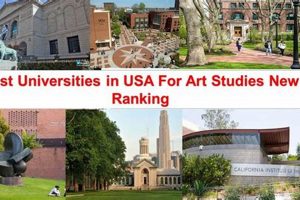Top-tier institutions for art education within the United States offer rigorous programs designed to cultivate artistic talent and prepare students for professional careers. These institutions provide specialized instruction in various disciplines, including painting, sculpture, photography, graphic design, and digital media. For example, curriculum may encompass studio practice, art history, theory, and professional development opportunities.
Access to renowned faculty, state-of-the-art facilities, and vibrant artistic communities contributes significantly to a student’s growth and future success. Historically, these hubs of creativity have played a crucial role in shaping artistic movements and fostering innovation within the broader cultural landscape. A strong foundation in both theoretical and practical skills provides graduates with a competitive edge in the art world and related industries.
This article will explore various factors to consider when selecting an art program, delve into specific institutions renowned for their excellence, and examine the evolving landscape of art education in the United States.
Tips for Selecting a Top Art Program
Choosing the right art program is a crucial step for aspiring artists. Careful consideration of individual artistic goals, program strengths, and career aspirations is essential for a successful educational experience.
Tip 1: Portfolio Development: A well-curated portfolio showcasing artistic skills and potential is paramount. Focus on demonstrating technical proficiency, creativity, and a cohesive artistic vision.
Tip 2: Faculty Expertise: Research the faculty’s backgrounds, artistic accomplishments, and teaching philosophies. Seek programs with instructors whose expertise aligns with individual artistic interests.
Tip 3: Program Focus: Consider the program’s specialization and curriculum. Some institutions excel in specific areas, such as animation, photography, or fine arts. A program’s focus should align with one’s artistic goals.
Tip 4: Resources and Facilities: Evaluate the availability of studio space, equipment, libraries, and other resources. Access to state-of-the-art facilities can significantly enhance the learning experience.
Tip 5: Location and Community: The surrounding artistic community and location can influence creative development. Consider the benefits of urban versus rural settings and the proximity to galleries, museums, and artistic networks.
Tip 6: Career Services: Investigate the career services offered by the institution. Strong career support can assist with internships, portfolio reviews, and job placement after graduation.
Tip 7: Financial Aid and Scholarships: Explore available financial aid options and scholarship opportunities. Understanding the costs and funding possibilities is essential for making informed decisions.
Careful consideration of these factors will contribute significantly to selecting an art program that nurtures artistic talent and prepares individuals for successful careers in the arts.
By following these guidelines, prospective students can navigate the complexities of choosing an art program and make informed decisions aligned with their artistic aspirations. The next section will provide concluding thoughts on the importance of art education and its impact on the future of the arts.
1. Faculty Expertise
Distinguished faculty represents a cornerstone of leading art institutions. The quality of instruction directly influences student development, artistic growth, and career trajectory. Examining faculty expertise provides crucial insight into the overall excellence of an art program.
- Professional Accomplishments:
Faculty members at top art schools often possess significant accomplishments within their respective fields. These accomplishments may include exhibitions in renowned galleries and museums, prestigious awards and grants, published works, and contributions to artistic discourse. Such achievements demonstrate a high level of proficiency and a commitment to artistic practice, enriching the learning environment for students.
- Diversity of Specialization:
Leading art programs cultivate a diverse faculty representing a wide range of artistic disciplines. This diversity ensures students access to specialized instruction across various media and artistic approaches. Exposure to diverse perspectives broadens students’ artistic horizons and encourages exploration and innovation.
- Mentorship and Guidance:
Effective mentorship plays a vital role in student development. Faculty in top art schools provide individualized guidance, fostering critical thinking, technical skill development, and the cultivation of a unique artistic voice. This personalized attention contributes significantly to student success both during their education and in their subsequent careers.
- Industry Connections:
Established faculty often maintain strong connections within the professional art world. These connections can provide valuable opportunities for students, including internships, exhibitions, and networking possibilities. Access to a network of established professionals can facilitate career pathways and enhance students’ integration into the broader artistic community.
The caliber of faculty expertise directly correlates with the overall quality of an art education. Institutions boasting accomplished, diverse, and dedicated faculty provide students with an unparalleled learning experience, contributing significantly to their artistic growth and professional development. Therefore, the strength of the faculty should be a primary consideration when evaluating and selecting an art program.
2. Program Diversity
A hallmark of leading art institutions in the United States lies in the breadth and depth of their program offerings. Program diversity cultivates a vibrant learning environment, catering to a wide spectrum of artistic interests and fostering interdisciplinary exploration. This variety allows students to specialize in chosen areas while broadening their artistic horizons, a key factor in achieving excellence in art education.
- Interdisciplinary Opportunities:
Top art schools often encourage interdisciplinary exploration, allowing students to blend traditional artistic disciplines with other fields such as technology, design, or humanities. For example, a student focusing on sculpture might integrate digital fabrication techniques or explore the intersection of art and social justice. This cross-pollination of ideas fosters innovation and expands creative possibilities.
- Range of Media:
Leading institutions offer comprehensive programs encompassing diverse artistic media. From painting and drawing to photography, printmaking, sculpture, ceramics, and new media, students can delve into various forms of artistic expression. This exposure broadens technical skill sets and facilitates the discovery of individual artistic voices. The availability of specialized equipment and resources further enhances the learning experience in each medium.
- Theoretical and Critical Studies:
Art education extends beyond studio practice. Robust programs incorporate art history, theory, and critical studies, providing students with a contextual understanding of art’s historical and cultural significance. This intellectual framework sharpens critical thinking skills, informs creative processes, and prepares students for informed engagement with the art world.
- Study Abroad and Exchange Programs:
Many top art schools offer opportunities for international study and exchange programs. Immersing oneself in different cultural contexts provides invaluable artistic inspiration and expands perspectives. These experiences foster cross-cultural understanding and enrich artistic development, contributing to a more well-rounded artistic education.
The diversity of programs offered by leading art institutions in the US contributes significantly to their overall quality. By providing students with a wide range of options for specialization, interdisciplinary exploration, and theoretical grounding, these institutions foster artistic innovation and prepare graduates for successful and impactful careers in a dynamic art world. A broad curriculum caters to diverse artistic aspirations and equips students with the skills and knowledge necessary to thrive in a constantly evolving artistic landscape.
3. Resource Availability
Resource availability significantly impacts the quality of art education and plays a crucial role in distinguishing leading art institutions in the US. Access to state-of-the-art facilities, equipment, and learning resources directly influences student artistic development and prepares them for professional practice. Evaluating resource availability provides crucial insight into an institution’s commitment to providing a comprehensive and enriching educational experience.
- Studio Spaces:
Dedicated studio spaces form the foundation of artistic practice. Ample, well-equipped studios provide students with the necessary environment for exploration, experimentation, and creation. Access to specialized studios for painting, sculpture, printmaking, ceramics, photography, and digital media allows for focused development of technical skills. The availability of 24/7 access to studio facilities reflects an institution’s commitment to supporting student artistic endeavors.
- Equipment and Technology:
Access to cutting-edge equipment and technology is essential in contemporary art education. Leading art schools provide students with industry-standard tools and resources, including digital fabrication equipment, darkrooms, printmaking presses, and advanced software. This access enables students to explore diverse artistic techniques, develop proficiency in current technologies, and prepare for the demands of professional art practice.
- Library and Research Resources:
A comprehensive art library provides students with access to essential research materials, including art books, journals, archives, and digital databases. These resources support scholarly inquiry, facilitate art historical research, and provide context for creative practice. Access to extensive library collections enhances students’ understanding of art history, theory, and criticism, enriching their overall artistic education.
- Exhibition Spaces:
Opportunities to exhibit artwork contribute significantly to student artistic development. Leading art institutions provide dedicated exhibition spaces, both on campus and within the broader community, where students can showcase their work. These exhibition opportunities offer valuable experience in professional presentation, foster critical feedback, and contribute to building a professional portfolio.
The availability of these resources significantly influences the overall quality of art education and plays a crucial role in defining the best art schools in the US. Institutions that prioritize resource acquisition and provide students with access to state-of-the-art facilities, equipment, and learning materials cultivate an environment conducive to artistic growth, experimentation, and professional development. Therefore, resource availability should be a primary consideration for prospective students when evaluating art programs.
4. Alumni Success
Alumni success serves as a key indicator of a leading art institution’s effectiveness and lasting impact. The achievements of graduates reflect the quality of education, mentorship, and resources provided. Examining alumni accomplishments offers valuable insights into the long-term benefits and overall excellence associated with top art programs. A strong track record of alumni success often correlates with robust career services, industry connections, and a supportive alumni network, all contributing to the distinction of “best art schools in the US.” For instance, graduates exhibiting in prestigious galleries, securing prominent positions in creative industries, or receiving national recognition for their artistic contributions demonstrate the effectiveness of their educational foundation.
The career trajectories of alumni offer tangible evidence of a program’s ability to prepare students for professional success. Graduates working in established art institutions, leading design firms, or thriving as independent artists demonstrate the practical application of skills and knowledge acquired during their education. Specific examples, such as alumni winning prestigious awards like the Turner Prize or achieving recognition through major museum acquisitions, underscore the impact of high-quality art education. Furthermore, the establishment of successful creative businesses by alumni reflects entrepreneurial skills fostered within top art programs. These achievements contribute to the overall reputation and perceived value of an art school, strengthening its position among the “best.”
In summary, alumni success serves as a critical metric for evaluating art institutions. Analyzing career outcomes, achievements, and contributions to the art world provides prospective students with valuable insights into the potential long-term benefits of attending specific programs. The sustained success of alumni reinforces the connection between high-quality education, robust resources, and impactful career outcomes, further solidifying the reputation of the “best art schools in the US.” This understanding allows prospective students to make informed decisions aligned with their artistic aspirations and career goals, recognizing the significant role alumni success plays in defining institutional excellence.
5. Industry Connections
Strong industry connections distinguish leading art institutions and contribute significantly to their recognition as “best.” These connections bridge academic learning with professional practice, providing students with invaluable opportunities and enhancing career prospects. Cultivating relationships with galleries, museums, design firms, and other creative organizations offers pathways for internships, exhibitions, mentorships, and employment. Institutions fostering robust industry partnerships provide students with a competitive advantage, facilitating a smoother transition from academia to the professional art world.
For example, partnerships with prominent galleries can lead to curated student exhibitions, providing crucial exposure to the professional art market. Collaborations with design firms offer internship opportunities, allowing students to gain practical experience in real-world settings. Mentorship programs connecting students with established professionals foster individualized guidance and career development. These connections translate into tangible benefits, increasing the likelihood of post-graduate employment, freelance opportunities, and successful integration into the professional art world. Institutions lacking strong industry connections may limit students’ access to such opportunities, potentially hindering career advancement.
In summary, prioritizing industry connections represents a key characteristic of leading art schools. These partnerships provide essential bridges between academic study and professional practice, equipping students with practical experience, networking opportunities, and enhanced career prospects. Understanding the importance of these connections empowers prospective students to select institutions that offer optimal pathways for professional success within the competitive art world. This knowledge contributes to informed decision-making and aligns educational choices with long-term career aspirations within the visual arts and related creative industries.
6. Location & Culture
The location and culture surrounding an art institution significantly influence its quality and contribute to its potential recognition among the “best art schools in the US.” Geographic location impacts access to artistic resources, influences creative networks, and shapes the overall learning experience. Urban centers, often rich in museums, galleries, and vibrant art scenes, offer students unparalleled exposure to contemporary art practices and professional opportunities. For example, institutions located in New York City provide access to world-renowned museums like the Museum of Modern Art (MoMA) and the Metropolitan Museum of Art, fostering deeper engagement with art history and contemporary trends. Conversely, institutions situated in rural settings might offer unique access to natural landscapes, fostering different creative explorations and a more focused learning environment. The cultural context, including local artistic traditions, community engagement, and the broader intellectual environment, shapes the character of an institution and influences the artistic development of its students. Consider the distinct cultural landscapes of Los Angeles, known for its film and entertainment industries, versus Chicago, recognized for its architectural heritage and public art scene. These varied environments cultivate unique artistic communities and influence the pedagogical approaches of art schools located within them.
Furthermore, the interplay between location and culture shapes the opportunities available to students. Proximity to major art markets and creative industries provides access to internships, exhibitions, and professional networks. Institutions located in thriving art hubs often attract visiting artists, critics, and curators, enriching the learning environment and fostering dialogue between students and established professionals. The cultural fabric of a location, including its diversity, social activism, and historical significance, can inspire artistic exploration and contribute to the development of unique artistic voices. For instance, institutions located in regions with rich Indigenous artistic traditions may incorporate these influences into their curriculum, fostering cross-cultural understanding and promoting diverse artistic expressions. Conversely, locations with a strong focus on technological innovation might encourage the integration of digital media and interdisciplinary practices within art programs. Understanding the dynamic relationship between location and culture provides valuable insights into the unique characteristics of each institution and its potential impact on a student’s artistic journey.
In conclusion, the symbiotic relationship between location and culture plays a crucial role in defining the character and quality of art institutions. Geographic location influences access to resources, exposure to artistic communities, and the overall learning experience. The cultural context shapes artistic expression, fosters creative networks, and informs pedagogical approaches. Recognizing the importance of location and culture empowers prospective students to select institutions aligned with their artistic aspirations and career goals. This understanding provides a nuanced perspective on the multifaceted factors contributing to the designation of “best art schools in the US,” emphasizing the dynamic interplay between geographical context, cultural influences, and artistic development.
Frequently Asked Questions
This section addresses common inquiries regarding top art programs in the United States. Understanding these key aspects assists prospective students in navigating the complexities of art school selection and making informed decisions aligned with individual artistic goals.
Question 1: What distinguishes top art programs from others?
Distinguished faculty, comprehensive resources, diverse program offerings, strong industry connections, successful alumni networks, and a supportive learning environment characterize leading art institutions.
Question 2: How important is portfolio development for art school applications?
A well-crafted portfolio showcasing artistic skills, creativity, and individual vision is essential for admission to competitive art programs. It serves as a primary representation of an applicant’s potential.
Question 3: What factors should be considered when choosing a specialization within art?
Careful consideration of individual artistic interests, career aspirations, program strengths, faculty expertise, and available resources should guide specialization selection.
Question 4: What are the typical costs associated with attending a leading art school?
Tuition, fees, supplies, and living expenses vary significantly among institutions. Thorough research and exploration of financial aid options are crucial for informed financial planning.
Question 5: How can one determine the right fit when selecting an art program?
Visiting campuses, attending virtual information sessions, connecting with current students and alumni, and thoroughly researching program offerings can provide valuable insights into institutional culture and program fit.
Question 6: What career opportunities are available to graduates of top art programs?
Graduates pursue diverse career paths, including fine arts, graphic design, illustration, animation, art education, art administration, curatorial work, and other creative industries.
Careful consideration of these frequently asked questions provides prospective students with a foundational understanding of crucial factors influencing art school selection and successful career pathways. Informed decision-making requires diligent research, self-reflection, and alignment of individual artistic goals with institutional strengths.
The following section will offer concluding remarks and summarize key takeaways for aspiring artists seeking exceptional art education in the United States.
Conclusion
Leading art institutions in the United States offer unparalleled opportunities for artistic growth, professional development, and creative exploration. Factors such as faculty expertise, program diversity, resource availability, alumni success, industry connections, and location significantly influence institutional quality and contribute to the distinction of “best.” Careful consideration of these elements empowers prospective students to make informed decisions aligned with individual artistic aspirations and career goals. Access to state-of-the-art facilities, renowned faculty, and vibrant artistic communities nurtures talent and fosters innovation within the broader cultural landscape. Understanding the nuanced interplay of these factors provides a comprehensive framework for evaluating art programs and identifying institutions best suited to individual needs and ambitions.
The pursuit of artistic excellence requires dedication, rigorous training, and a supportive environment. Choosing the right institution plays a crucial role in shaping artistic trajectories and fostering lifelong creative development. Aspiring artists seeking transformative educational experiences must prioritize informed decision-making, aligning personal artistic visions with institutional strengths and resources. The future of art relies on cultivating emerging talent and providing access to exceptional educational opportunities. By understanding the defining characteristics of leading art programs, prospective students can embark on a path toward artistic fulfillment and contribute meaningfully to the evolving landscape of contemporary art.







